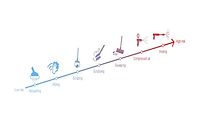In food processing, proper maintenance is important to ensure a sanitary processing facility. Properly selecting and using the right tools and equipment for each assigned task is essential to success, as is ongoing care, cleaning and maintenance of those tools and equipment.
As the U.S.-exclusive Vikan® partner supplying color-coded tools for the food processing industry, Remco Products is pleased to share this guide to the proper selection, care and maintenance of food contact tools and equipment. We’ll explain the best way to store and clean food contact and hygienic cleaning tools and provide helpful long-term maintenance tips.
Hygienic Cleaning
Hygienic cleaning tools and methods safeguard people’s health and safety. In many cases, hygienic cleaning is a necessary step to maintain an efficient, clean and code-compliant processing facility—one that controls internal hygiene, mitigates cross-contamination at every step and documents the cleanliness of the process. Thus, it is important that the proper tools, cleaning and storage methods, and maintenance practices are utilized to assure the highest level of integrity.
Tool Selection
It’s important to begin by choosing the proper tools for the specific area or task. Remco and Vikan products are specifically designed to meet the needs of food processing U.S. Food and Drug Administration-compliant materials, featuring a smooth, ergonomic, one-piece construction.
Storage
Proper storage in a clean, protected storage area ensures good hygiene and helps extend tool life. A variety of wall brackets are available to conveniently store brushes, squeegees, brooms, dustpans and other food contact tools and equipment.
Extreme temperatures and/or humidity levels can affect the life and lasting quality of the food contact tools and equipment. Extremely cold temperatures can cause fracturing of tools and possible physical hazards in a food facility. High-humidity areas that do not allow for proper tool drying can support the growth of microbial hazards. Multiple storage locations may be useful, depending on whether the tool is needed during processing or only during sanitation processes.
Maintenance/Replacement
Removing the nutrients that bacteria need to grow and killing the bacteria present on food contact surfaces are the fundamentals of effectively cleaning food contact tools and equipment. The removal of visible contamination such as food soils or loose debris is only the first step. It’s critical that personnel understand that proper cleaning is a process that must be followed, regardless of the time necessary.
Cleaning
Food contact equipment and tools should be regularly maintained according to industry standards. In most cases, the cleaning method will be determined by the area, the equipment design, the facility environment, the equipment’s zone in the facility (e.g., food contact or not), the target concerns (e.g., pathogens and allergens) and how often the equipment is cleaned. Generally, guidelines call for the removal of gross debris; tools should be rinsed with water to remove any additional loose debris and then washed in water containing a detergent or chemical deemed appropriate by the particular industry’s standards. All contamination should be removed until it is visibly clean. This should be followed by a rinse that removes any detergent/chemicals used.
Sterilizing/Disinfecting
Certain industries require sterilizing or disinfecting of material handling and cleaning tools. One option is to use an autoclave, which works with a combination of temperature, pressure and time. Depending on the food category and the particular microbiological contaminants of concern, different guidelines may apply as to the proper combination of temperature, pressure and time that should be followed to ensure proper sterilization of the tools and equipment.
Food companies will typically sanitize their equipment and tools using chemical sanitizers. A number of sanitizers are popular with food processors, because they do not require a rinse after their application. Check industry and chemical supplier recommendations for more specific autoclave and chemical guidelines based on your facilities’ needs. Once a chemical has been added to a cleaning process, its removal should also be accounted for to ensure that the chemical does not in any way come into contact with food materials or becomes a part of future food processing cycles.
Tool Life Span
Food contact tools and equipment should be regularly inspected for damage and replaced when there are excessive abrasions or gouges, damaged bristles, severe discoloration, staining or the tools are worn to the point where they could be a hazard to the user.
www.remcoproducts.com



